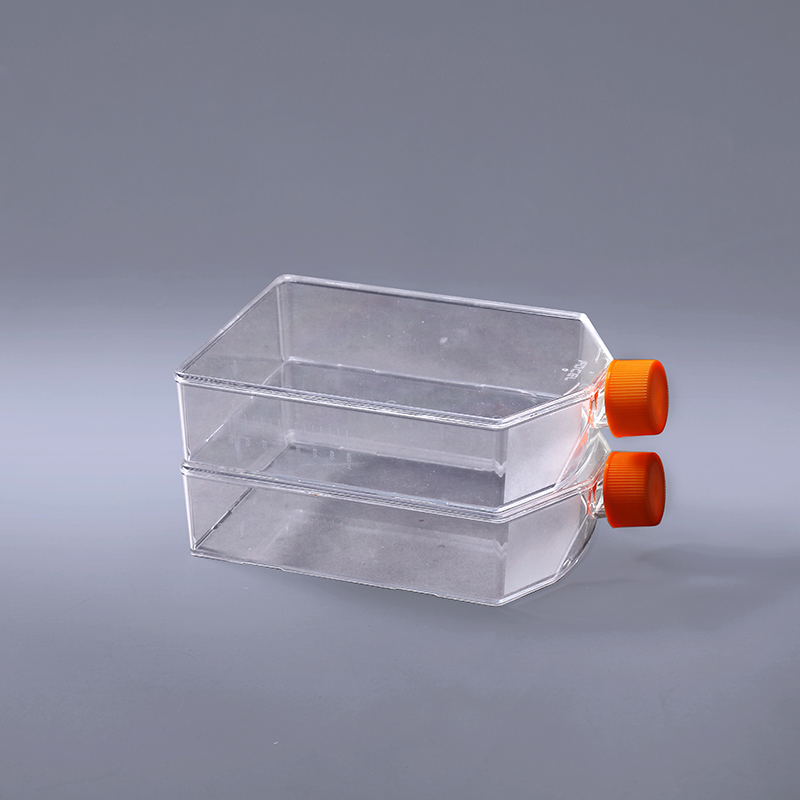Tá an cell cultureflaks déanta as ábhar polaistiréin grád leighis le trédhearcacht ard. De réir próisis cóireála dromchla éagsúla, tá sé roinnte ina dhá chineál: hydrophilic and hydrophobic.
fleascán cultúr cille hidreafóbach : a úsáidtear chun cealla greamaitheacha a shaothrú. Ní mór go mbeadh dromchla tacaíochta ag fás cealla den sórt sin is féidir a cheangal, agus is féidir leis na cealla fás agus atáirgeadh ar an dromchla seo trí bheith ag brath ar fhachtóirí ceangail atá secreted acu féin nó a chuirtear ar fáil sa mheán cultúir. Tá cóireáil speisialta modhnaithe déanta ar dhromchla an bhuidéil chun grúpaí hidrofilic a thabhairt isteach. Is é an cuspóir atá leis seo ná feidhmíocht greamaitheachta dhromchla an bhuidéil a mhéadú, atá níos oiriúnaí d'fhás cille. Níl fás na gcealla seo ag brath ar dhromchla na tacaíochta agus fásann sé i bhfionraí sa mheán cultúir. Tugtar cealla fionraíochta ar chealla den sórt sin. Den sórt sin mar limficítí. Go ginearálta tá struchtúr ceann-go-eireaball ag polaistiréin, is slabhra carbóin sáithithe é an príomhshlabhra, agus is fáinne beinséine comhchuingeach é an grúpa taobh, rud a fhágann go bhfuil an struchtúr móilíneach neamhrialta, go n-ardóidh rigidity an mhóilín, agus déanann sé PS neamh-. polaiméir líneach criostalach. Tá leibhéal áirithe hidreafóbachta aige, mar sin is féidir an dromchla a úsáid le haghaidh cultúr cille fionraí gan chóireáil speisialta.
Hydrophobic cell culture flaskIs iad seo thuas dhá chineál fleascáin cultúir cille, atá oiriúnach go príomha do mheánscála. cultúr cille agus fíocháin sa tsaotharlann. Éascaíonn an dearadh scrogaill leathan an pípéad agus an scraper cille teagmháil a dhéanamh leis an dromchla fáis.
The above are two types of cell culture flasks, which are mainly suitable for medium-scale cell and tissue culture in the laboratory. The wide bottleneck design facilitates the pipette and cell scraper to contact the growth surface.
The FAI climbed 5.9 percent year-on-year in the first 11 months of 2018, quickening from the 5.7-percent growth in Jan-Oct, the National Bureau of Statistics (NBS) said Friday in an online statement.
The key indicator of investment, dubbed a major growth driver, hit the bottom in August and has since started to rebound steadily.
In the face of emerging economic challenges home and abroad, China has stepped up efforts to stabilize investment, in particular rolling out measures to motivate private investors and channel funds into infrastructure.
Friday's data showed private investment, accounting for more than 60 percent of the total FAI, expanded by a brisk 8.7 percent.
NBS spokesperson Mao Shengyong said funds into weak economic links registered rapid increases as investment in environmental protection and agriculture jumped 42 percent and 12.5 percent respectively, much faster than the average.
In breakdown, investment in high-tech and equipment manufacturing remained vigorous with 16.1-percent and 11.6-percent increases respectively in the first 11 months. Infrastructure investment gained 3.7 percent, staying flat. Investment in property development rose 9.7 percent, also unchanged.
 English
English



















































